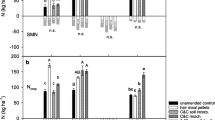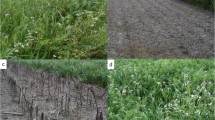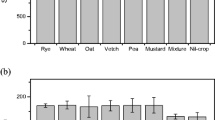Abstract
Cover crops can improve internal nitrogen (N) cycling in agroecosystems while increasing crop yield, with mixtures potentially providing more benefits than monocultures. Cover crops may be especially useful for organic vegetable producers that have few options to meet crop N demand with certified organic products. We established a two-year experiment comparing the effects of five summer cover crop treatments–monocultures of Sunn hemp (SH) or Sorghum sudangrass (SSG), a SH-SSG mixture, and mixtures of 3 species (SH-SSG + buckwheat) or 5 species (SH-SSG + buckwheat, cowpea and sunflower)–on cover crop biomass production, soil N cycling, and yields of organic vegetables. Nitrogen concentrations were determined in the biomass of cover crops and cash crops, soils were sampled regularly for inorganic N and potential net N mineralization, and total soil N was measured at the beginning and end of the experiment. Partial N budgets were also computed. In both years, aboveground cover crop biomass was lowest in SSG (4,500–5,900 kg ha−1) and greatest in SH + SSG (7,600–9,200 kg ha−1). High cover crop biomass production led to large N quantities being returned to the soil (66–155 kg N ha−1), although this did not increase soil N availability and yields compared to plots without cover crops. Partial N budgets showed large N surpluses, with less than 20% of the N added with fertilizer recovered in harvested crops. Overall, these results suggest a small transfer of cover crop N to subsequent cash crops in organic vegetable production, resulting in limited benefits.





Similar content being viewed by others
References
Biswas T, Guan Z, Wu F (2017) An Overview of the US Bell Pepper Industry. Gainesville, FL
Borrelli K (2020) Cover Crop Mixtures: Calculating Seeding Rates. PennState Extension, United States of America
Brennan EB, Boyd NS (2012) Winter cover crop seeding rate and variety affects during eight years of organic vegetables: II. cover crop nitrogen accumulation. Agron J 104:799–806. https://doi.org/10.2134/agronj2011.0331
Cherr CM, Scholberg JMS, McSorley R (2006a) Green manure approaches to crop production: A synthesis. Agron J 98:302–319. https://doi.org/10.2134/agronj2005.0035
Cherr CM, Scholberg JMS, McSorley R (2006b) Green manure as nitrogen source for sweet corn in a warm-temperate environment. Agron J 98:1173–1180. https://doi.org/10.2134/agronj2005.0036
Clark A (ed) (2012) Managing Cover Crops Profitably, 3rd edn. Sustainable Agriculture Research and Education, College Park, MD
Clark AJ, Meisinger JJ, Decker AM, Mulford FR (2007) Effects of a grass-selective herbicide in a vetch-rye cover crop system on nitrogen management. Agron J 99:36–42. https://doi.org/10.2134/agronj2005.0361
Congreves KA, Van Eerd LL (2015) Nitrogen cycling and management in intensive horticultural systems. Nutr Cycl Agroecosystems 102:299–318. https://doi.org/10.1007/s10705-015-9704-7
Crews TE, Peoples MB (2005) Can the synchrony of nitrogen supply and crop demand be improved in legume and fertilizer-based agroecosystems? A review. Nutr Cycl Agroecosystems 72:101–120. https://doi.org/10.1007/s10705-004-6480-1
De Notaris C, Rasmussen J, Sørensen P, Olesen JE (2018) Nitrogen leaching: A crop rotation perspective on the effect of N surplus, field management and use of catch crops. Agric Ecosyst Environ 255:1–11. https://doi.org/10.1016/j.agee.2017.12.009
Doane TA, Horwáth WR (2003) Spectrophotometric Determination of Nitrate with a Single Reagent. Anal Lett 36:2713–2722. https://doi.org/10.1081/AL-120024647
Finney DM, White CM, Kaye JP (2016) Biomass Production and Carbon/Nitrogen Ratio Influence Ecosystem Services from Cover Crop Mixtures. Agron J 108:39–52. https://doi.org/10.2134/agronj15.0182
Goulding K (2000) Nitrate leaching from arable and horticultural land. Soil Use Manag 16:145–151. https://doi.org/10.1111/j.1475-2743.2000.tb00218.x
Hartz TK, Johnstone PR (2006) Nitrogen availability from high-nitrogen-containing organic fertilizers. HortTechnology 16:39–42
Hooper D (1998) The Role of Complementarity and Competition in Ecosystem responses to Cariation in Plant Diversity. Ecology 79:704–719. https://doi.org/10.1890/0012-9658(1998)079[0704:TROCAC]2.0.CO;2
Houlton BZ, Boyer E, Finzi A et al (2013) Intentional versus unintentional nitrogen use in the United States: Trends, efficiency and implications. Biogeochemistry 114:11–23. https://doi.org/10.1007/s10533-012-9801-5
Kniss AR, Savage SD, Jabbour R (2016) Commercial crop yields reveal strengths and weaknesses for organic agriculture in the United States. PLoS ONE 11:1–16. https://doi.org/10.1371/journal.pone.0161673
Li X, Sørensen P, Li F et al (2015) Quantifying biological nitrogen fixation of different catch crops, and residual effects of roots and tops on nitrogen uptake in barley using in-situ 15N labelling. Plant Soil 395:273–287. https://doi.org/10.1007/s11104-015-2548-8
Li J, Zhao X, Maltais-Landry G, Paudel BR (2021) Dynamics of Soil Nitrogen Availability Following Sunn Hemp Residue Incorporation in Organic Strawberry Production Systems. HortSci Horts 56:138–146
Linares J, Scholberg J, Boote K et al (2008) Use of the cover crop weed index to evaluate weed suppression by cover crops in organic citrus orchards. HortScience 43:27–34
Liu G, Simonne EH, Morgan KT, et al (2019) Chapter 2. Fertilizer Management for Vegetable Production in Florida. In: Vegetable Handbook of Florida, 2018–2019
Maltais-Landry G, Scow K, Brennan E et al (2016) Higher flexibility in input N: P ratios results in more balanced phosphorus budgets in two long-term experimental agroecosystems. Agric Ecosyst Environ 223:197–210. https://doi.org/10.1016/j.agee.2016.03.007
Möller K, Stinner W, Leithold G (2008) Growth, composition, biological N2 fixation and nutrient uptake of a leguminous cover crop mixture and the effect of their removal on field nitrogen balances and nitrate leaching risk. Nutr Cycl Agroecosystems 82:233–249. https://doi.org/10.1007/s10705-008-9182-2
Munoz-Carpena R, Ritter A, Bosch DD et al (2008) Summer cover crop impacts on soil percolation and nitrogen leaching from a winter corn field. Agric Water Manag 95:633–644. https://doi.org/10.1016/j.agwat.2008.01.005
O’Connell S, Shi W, Grossman JM et al (2015) Short-term nitrogen mineralization from warm-season cover crops in organic farming systems. Plant Soil 396:353–367. https://doi.org/10.1007/s11104-015-2594-2
Perrone S, Grossman J, Liebman A et al (2020) Nitrogen fixation and productivity of winter annual legume cover crops in Upper Midwest organic cropping systems. Nutr Cycl Agroecosystems 117:61–76. https://doi.org/10.1007/s10705-020-10055-z
Poffenbarger HJ, Mirsky SB, Weil RR et al (2015a) Legume proportion, poultry litter, and tillage effects on cover crop decomposition. Agron J 107:2083–2096. https://doi.org/10.2134/agronj15.0065
Poffenbarger HJ, Mirsky SB, Weil RR et al (2015b) Biomass and nitrogen content of hairy vetch-cereal rye cover crop mixtures as influenced by species proportions. Agron J 107:2069–2082. https://doi.org/10.2134/agronj14.0462
Quemada M, Cabrera ML (1995) Carbon and Nitrogen Mineralized from Leaves and Stems of Four Cover Crops. Soil Sci Soc Am J 59:471–477. https://doi.org/10.2136/sssaj1995.03615995005900020029x
R Core Team (2020) R: A language and Environment for Statistical Computing
Ranaldo M, Carlesi S, Costanzo A, Bàrberi P (2019) Functional diversity of cover crop mixtures enhances biomass yield and weed suppression in a Mediterranean agroecosystem. Weed Res 60:96–108. https://doi.org/10.1111/wre.12388
Ranells NN, Wagger MG (1996) Nitrogen release from grass and legume cover crop monocultures and bicultures. Agron J 88:777–782. https://doi.org/10.2134/agronj1996.00021962008800050015x
Ranells NN, Wagger MG (1997) Winter annual grass-legume bicultures for efficient nitrogen management in no-till corn. Agric Ecosyst Environ 65:23–32. https://doi.org/10.1016/S0167-8809(97)00054-6
Ribaudo M, Delgado J, Hansen L, et al (2011) United States Department of Agriculture Economic Research Service Nitrogen in Agricultural Systems: Implications for Conservation Policy Economic Research Report Number 127
Robertson GP, Vitousek PM (2009) Nitrogen in Agriculture: Balancing the Cost of an Essential Resource. Annu Rev Environ Resour 34:97–125. https://doi.org/10.1146/annurev.environ.032108.105046
Robertson GP, Wedin D, Groffman PM et al (1999) Soil Carbon and Nitrogen Availability - Nitrogen Mineralization, Nitrification, and Soil Respiration Potentials. In: Robertson GP, Coleman DC, Bledsoe CS, Sollins P (eds) Standard soil methods for long-term ecological research. Oxford University Press, New York, pp 258–271
Schipanski ME, Drinkwater LE (2012) Nitrogen fixation in annual and perennial legume-grass mixtures across a fertility gradient. Plant Soil 357:147–159. https://doi.org/10.1007/s11104-012-1137-3
Schipanski ME, Barbercheck M, Douglas MR et al (2014) A framework for evaluating ecosystem services provided by cover crops in agroecosystems. Agric Syst 125:12–22. https://doi.org/10.1016/j.agsy.2013.11.004
Seufert V, Ramankutty N, Foley JA (2012) Comparing the yields of organic and conventional agriculture. Nature 485:229–232. https://doi.org/10.1038/nature11069
Simonne EH, Dukes MD, Hochmuth RC et al (2006) Scheduling Drip Irrigation for Bell Pepper Grown with Plasticulture. J Plant Nutr 29:1729–1739. https://doi.org/10.1080/01904160600897448
Stoffella PJ, Locascio SJ, Howe TK et al (1995) Yield and fruit size stability differs among bell pepper cultivars. J Am Soc Hortic Sci 120:325–328
Syswerda SP, Basso B, Hamilton SK et al (2012) Long-term nitrate loss along an agricultural intensity gradient in the Upper Midwest USA. Agric Ecosyst Environ 149:10–19. https://doi.org/10.1016/j.agee.2011.12.007
Thapa R, Mirsky SB, Tully KL (2018) Cover Crops Reduce Nitrate Leaching in Agroecosystems: A Global Meta-Analysis. J Environ Qual 47:1400–1411. https://doi.org/10.2134/jeq2018.03.0107
Tonitto C, David MB, Drinkwater LE (2006) Replacing bare fallows with cover crops in fertilizer-intensive cropping systems: A meta-analysis of crop yield and N dynamics. Agric Ecosyst Environ 112:58–72. https://doi.org/10.1016/J.Agee.2005.07.003
Treadwell D, Huang P (2010) Buckwheat: A Cool-Season Cover Crop for Florida Vegetable Systems. Univ Florida, IFAS Ext 1–6
Weatherburn MW, Lubochinsky B, Zalta JP, St B (1954) Phenol-Hypochlorite Reaction for Determination of Ammonia. Anal Chem 39:971–974. https://doi.org/10.1021/ac60252a045
Wortman SE, Francis CA, Lindquist JL (2012) Cover crop mixtures for the western Corn Belt: Opportunities for increased productivity and stability. Agron J 104:699–705. https://doi.org/10.2134/agronj2011.0422
Yan Z, Liu P, Li Y et al (2013) Phosphorus in China’s Intensive Vegetable Production Systems: Overfertilization, Soil Enrichment, and Environmental Implications. J Environ Qual 42:982–989. https://doi.org/10.2134/jeq2012.0463
Acknowledgements
We thank the UF/IFAS College of Agricultural and Life Sciences Field and Fork Program (Anna Prizzia, James Longanecker, Dr. Dina Liebowitz, Claudie Babineaux) for logistical support, including interns and volunteers that helped with field maintenance. Mia Acker, Kayci Anderson, Madelene Clark, Sean Coughlin, Jennifer Cumbie, Adnan Fatehi, Emma Goldberg, Mica James, Dawn Lucas, Kaitlyn Tucker, and Ethan Weinrich assisted with field and lab work. Dr. Diane Rowland and Dr. Sarah Strauss helped advising and mentoring J. Allar.
Funding
The UF/IFAS College of Agricultural and Life Sciences Field and Fork Program (assistantship to J. Allar, supplies), the University of Florida’s Soil and Water Sciences Department, and USDA NIFA, Hatch project FLA-SWS-005733.
Author information
Authors and Affiliations
Corresponding author
Ethics declarations
Conflict of interest
The authors declare no conflicts of interest.
Additional information
Publisher's Note
Springer Nature remains neutral with regard to jurisdictional claims in published maps and institutional affiliations.
Supplementary Information
Below is the link to the electronic supplementary material.
Rights and permissions
About this article
Cite this article
Allar, J., Maltais-Landry, G. Limited benefits of summer cover crops on nitrogen cycling in organic vegetable production. Nutr Cycl Agroecosyst 122, 119–138 (2022). https://doi.org/10.1007/s10705-021-10189-8
Received:
Accepted:
Published:
Issue Date:
DOI: https://doi.org/10.1007/s10705-021-10189-8




